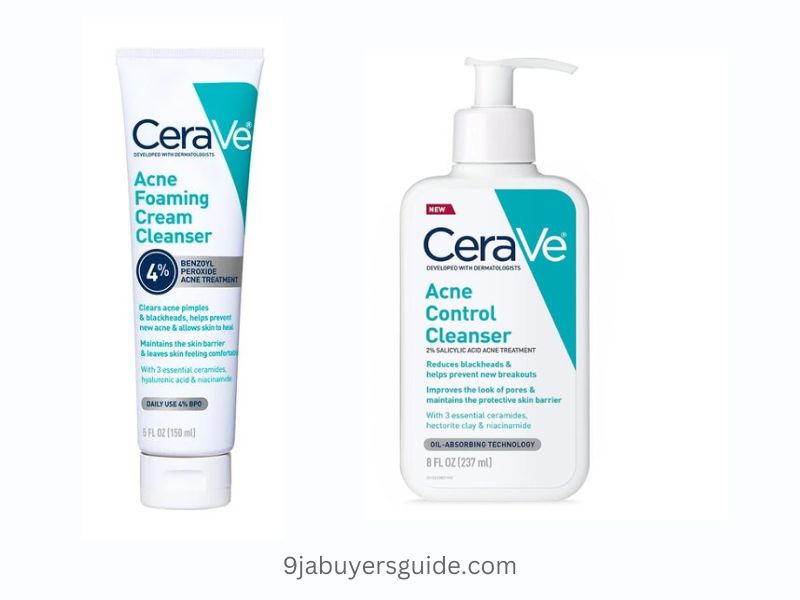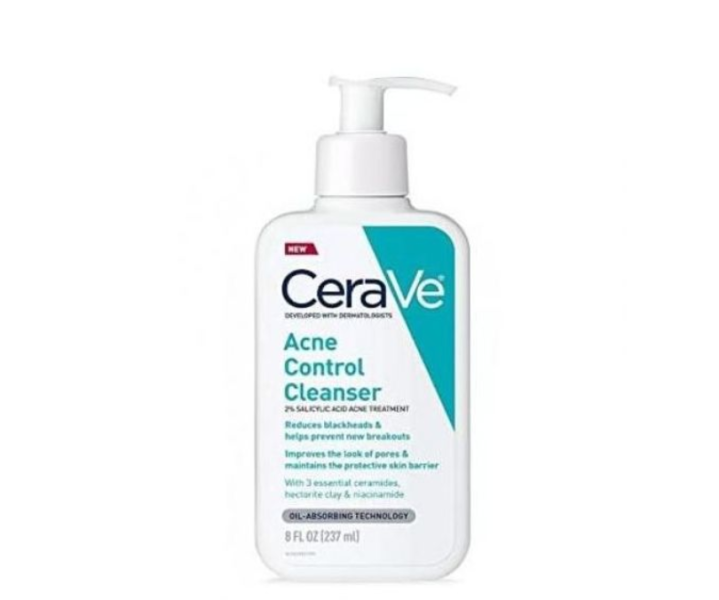So, you’re wondering which CeraVe cleanser is best for acne, right? Of course, CeraVe has different cleansers, and it is important to get the right one to use. If you intend to get the right one for an acne-prone skin, you’re on the right page.
According to reviews by expert on Cerave official site, the CeraVe Acne Foaming Cleanser and the CeraVe Acne Control Cleanser are good options for acne-prone skin. These products are respectively empowered with benzoyl peroxide and salycylic acid, which are notable for their acne-fighting power.
Mind you, to get the best of these cleanser, there are certain actions you need to take. You’ll find out all about them in this guide as you read further.

CeraVe Clenser for Acne?
Here are the best CeraVe cleansers for acne:
1. CeraVe Acne Foaming Cream Cleanser

The CeraVe Acne Foaming Cream Cleanser is a skincare product that is regarded for its acne-fighting power. It contains several key ingredients that contribute to its effectiveness in addressing the skin condition.
Amongst the key ingredients of this cleanser is benzoyl peroxide, hyaluronic acid, and niacinamide. In fact, as noted by CeraVe, the Acne Foaming Cleanser is the brand’s first acne-fighting product that work with 4% benzoyl peroxide to clear acne.
Here are some additional notes about its formulation:
a. Benzoyl Peroxide
Benzoyl peroxide is a common and effective ingredient in many acne-fighting products. Its primary role is to treat acne by targeting the factors that contribute to its development.
This formula has proven to effectively kill the bacteria Propionibacterium acnes (P. acnes), which is one of the main acne-causing bacteria. By reducing the number of bacteria on the skin, benzoyl peroxide helps to minimize inflammation and prevent the formation of new acne lesions.
b. Hyaluronic Acid
Hyaluronic acid is a substance that occurs naturally in the body and is known for its ability to attract and retain moisture. In skincare products, including the CeraVe Acne Foaming Cleanser, hyaluronic acid is often included for its hydrating properties.
This substance is known to help maintain skin hydration while the cleanser addresses acne-related concerns. However, because some acne-fighting ingredients or cleansing agents may have the potential to strip the skin of natural moisture, this substance helps to counteract potential dryness or dehydration caused by the cleansing process.
Hyaluronic acid attracts water molecules and helps to keep the skin hydrated, contributing to a balanced and moisturized complexion.
c. Ceramides
Another notable ingredient in this cleanser is ceramide. Ceramides are natural components of the skin that help to build and maintain its outermost layer, often referred to as the skin’s barrier. This barrier acts like a shield, keeping the skin hydrated, protecting it from harmful environmental factors, and preventing moisture loss.
When ceramide levels are balanced, the skin remains healthy and resilient. This is important because acne treatments can sometimes be drying, and maintaining a healthy barrier helps to prevent excessive dryness and irritation.
d. Niacinamide
Niacinamide, also known as vitamin B3, has anti-inflammatory properties and can help reduce redness and irritation associated with acne. It also assists in regulating sebum production, which is beneficial for controlling excess oil that can contribute to acne.
2. CeraVe Acne Control Cleanser

CeraVe Acne Control Cleanser is a skincare product specifically formulated to help treat and prevent acne. It combines several key ingredients that work together to address acne-related concerns.
Here are the key ingredients in the cleanser and how it helps treat acne:
a. Hectorite Clay
Hectorite clay is often used in cosmetics and personal care products such as creams, lotions, and foundations. It acts as a thickening agent and helps improve the texture and spreadability of these products.
The presence of the purifying clay in the CeraVe Acne Control Cleanser, as revealed by CeraVe, helps to absorb excess oil, which contributes to its hydrating properties.
b. Salicylic Acid (2%)
The CeraVe Acne Control Cleanser also contains salicylic acid to help unclog pores. As noted by MedicalNews Today, salicylic acid can serve as a potent cosmetic ingredient for fighting acne.
However, it is noted that it may pose side effects like skin irritation, especially when used excessively. This explains why only 2% is present in the CeraVe Acne Control Cleanser.
c. Ceramides and Niacinamide
It also contains ceramides, which are naturally occurring lipids in the skin that play a crucial role in maintaining the skin’s barrier function, as noted in a study published by the National Library of Science. It, therefore, has the capacity to help maintain skin moisture and prevent irritation.
This cleanser also boasts a sizeable amount of niacinamide, which is beneficial for controlling excess sebum production that can contribute to acne development, as noted by Healthline.
You might also want to check out our guide on how to use:
Other Properties of the Two Cleansers That Help Combat Acne
Additionally, the following properties also help the CeraVe Renewing SA Cleanser and the CeraVe Acne Control Cleanser to maintain potency against acne issues:
a. They Offer Gentle Exfoliation
The exfoliating properties of the SA in these cleansers help to unclog pores, reduce the appearance of blackheads, and promote smoother skin texture.
Pores are tiny openings on the skin’s surface that house hair follicles and sebaceous (oil) glands. When they become clogged with excess oil, dead skin cells, and debris, they can create an ideal environment for acne-causing bacteria to thrive.
Blackheads are a type of acne lesion. They form when the contents of a clogged pore are exposed to air, causing them to oxidize and turn black. Blackheads are typically the result of excess oil production and dead skin cells that block the pore’s opening.
Moreover, note that acne can disrupt the skin’s texture, leading to roughness, unevenness, and the presence of acne scars. Inflammatory acne, in particular, can cause changes in skin texture as the body’s response to infection and inflammation affects the surrounding tissue.
Addressing these factors often involves proper skincare, including cleansing to prevent pore clogging, exfoliating to remove dead skin cells and improve texture, and using acne-fighting ingredients to manage blackheads and other acne lesions.
b. They Contain Non-Comedogenic Substance
CeraVe products, including these cleansers, are formulated to be non-comedogenic, meaning they won’t clog pores or exacerbate acne issues. This term is often used in the skincare industry to describe products that have been carefully formulated to minimize the likelihood of pore blockage.
This is why the cleansers are lightweight and designed to effectively clean the skin without leaving behind a residue that might lead to pore blockages.
Overall, either of the CeraVe Acne Foaming Cleanser or the Acne Control Cleanser could be a valuable addition to an acne-fighting skincare routine. They not only help to prevent and treat acne breakouts but also maintains the skin’s overall health and hydration.
However, it’s essential to use the product as directed and consult with a dermatologist for a personalized acne management plan, especially for severe or persistent acne concerns.
That said, it’s also important to know how to check out fake CeraVe products.
How To Incorporate the CeraVe Cleansers into Your Routine
If you’ve decided to give either the CeraVe Acne Foaming Cream Cleanser or the CeraVe Acne Control Cleanser a try, here are some tips for incorporating it into your skincare routine:
- Conduct Patch Test: Before applying the cleanser to your entire face, conduct a patch test on a small area of your skin to ensure there are no adverse reactions.
- Start Slowly: If you have dry or sensitive skin, begin by using the cleanser a few times a week and gradually increase frequency as your skin adapts.
- Follow with Moisturizer: After cleansing, apply a moisturizer to ensure your skin stays hydrated and balanced.
- Monitor Results: Keep track of how your skin responds to the cleanser over time. If you experience any discomfort or irritation, adjust your usage accordingly.
Common Misconceptions Involving Acne Skin Care
In your pursuit of clearer skin, it’s crucial to dispel common misconceptions that may hinder your progress. That said, let’s address some prevalent myths surrounding acne and skincare:
1. Over-Exfoliation Dilemma
While exfoliation is essential for removing dead skin cells and unclogging pores, over-exfoliation can disrupt the skin’s barrier and exacerbate acne. Always note that balance is key!
That said, incorporate the Cleanser a few times a week, gradually increasing usage as your skin adapts.
2. Avoid One-Size-Fits-All Mentality
Skincare is not a one-size-fits-all solution. Factors such as genetics, hormonal fluctuations, and lifestyle play a significant role in acne development. That said, always note that what works for one person may not necessarily yield the same results for another.
3. Instant Gratification Expectations
Additionally, achieving clearer skin is a gradual process that requires patience and consistency. While some individuals may experience rapid improvements with either of the two CeraVe Cleansers mentioned, others may require more time to see noticeable changes. So, avoid the trap of expecting overnight results.
Final Note
Over the years, the CeraVe Acne Foaming Cream Cleanser and the Acne Control Cleanser have emerged as good options for acne-fighting efforts. Their formulation addresses the root causes of the skin condition while contributing to a smoother, revitalized complexion.
However, it’s essential to recognize that skincare is a personal journey, and individual factors play a pivotal role in determining the best course of action. Now that you know the CeraVe cleansers that are best for acne. You can make your purchase decision with a more informed mind.
Sources:
Salicylic Acid vs. Benzoyl Peroxide: Which Is Better for Acne? – Healthline
Everything You Should Know About Niacinamide – Healthline
What is the Role of Benzoyl Peroxide Cleansers in Acne Management? – NIH
Salicylic Acid Gel – Uses, Side Effects, and More – WebMD
Salicylic acid for acne: Efficacy, how to use, and more – MedicalNews Today
Skin Barrier Function: The Interplay of Physical, Chemical, and Immunologic Properties – NCBI
